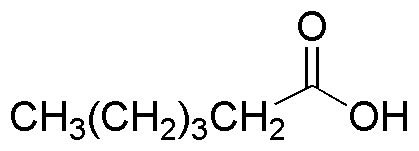Caproic acid is widely utilized in research focused on:
- Food Industry: Used as a flavoring agent, it imparts a creamy, buttery taste to various dairy products and baked goods, enhancing their appeal to consumers.
- Fragrance Industry: Its unique odor profile makes it a valuable ingredient in perfumes and scented products, providing a rich, fatty note that complements other fragrances.
- Pharmaceuticals: Employed as an intermediate in the synthesis of various drugs, it plays a crucial role in developing medications that require specific fatty acid structures.
- Cosmetics: Commonly found in skincare products, it acts as an emollient, helping to moisturize and soften the skin while improving product texture.
- Biodegradable Plastics: Used in the production of biodegradable polymers, it contributes to environmentally friendly packaging solutions, addressing sustainability concerns in the industry.
General Information
Properties
Safety and Regulations
Applications
Caproic acid is widely utilized in research focused on:
- Food Industry: Used as a flavoring agent, it imparts a creamy, buttery taste to various dairy products and baked goods, enhancing their appeal to consumers.
- Fragrance Industry: Its unique odor profile makes it a valuable ingredient in perfumes and scented products, providing a rich, fatty note that complements other fragrances.
- Pharmaceuticals: Employed as an intermediate in the synthesis of various drugs, it plays a crucial role in developing medications that require specific fatty acid structures.
- Cosmetics: Commonly found in skincare products, it acts as an emollient, helping to moisturize and soften the skin while improving product texture.
- Biodegradable Plastics: Used in the production of biodegradable polymers, it contributes to environmentally friendly packaging solutions, addressing sustainability concerns in the industry.
Documents
Safety Data Sheets (SDS)
The SDS provides comprehensive safety information on handling, storage, and disposal of the product.
Product Specification (PS)
The PS provides a comprehensive breakdown of the product’s properties, including chemical composition, physical state, purity, and storage requirements. It also details acceptable quality ranges and the product's intended applications.
Certificates of Analysis (COA)
Search for Certificates of Analysis (COA) by entering the products Lot Number. Lot and Batch Numbers can be found on a product’s label following the words ‘Lot’ or ‘Batch’.
*Catalog Number
*Lot Number
Certificates Of Origin (COO)
This COO confirms the country where the product was manufactured, and also details the materials and components used in it and whether it is derived from natural, synthetic, or other specific sources. This certificate may be required for customs, trade, and regulatory compliance.
*Catalog Number
*Lot Number
Safety Data Sheets (SDS)
The SDS provides comprehensive safety information on handling, storage, and disposal of the product.
DownloadProduct Specification (PS)
The PS provides a comprehensive breakdown of the product’s properties, including chemical composition, physical state, purity, and storage requirements. It also details acceptable quality ranges and the product's intended applications.
DownloadCertificates of Analysis (COA)
Search for Certificates of Analysis (COA) by entering the products Lot Number. Lot and Batch Numbers can be found on a product’s label following the words ‘Lot’ or ‘Batch’.
*Catalog Number
*Lot Number
Certificates Of Origin (COO)
This COO confirms the country where the product was manufactured, and also details the materials and components used in it and whether it is derived from natural, synthetic, or other specific sources. This certificate may be required for customs, trade, and regulatory compliance.

